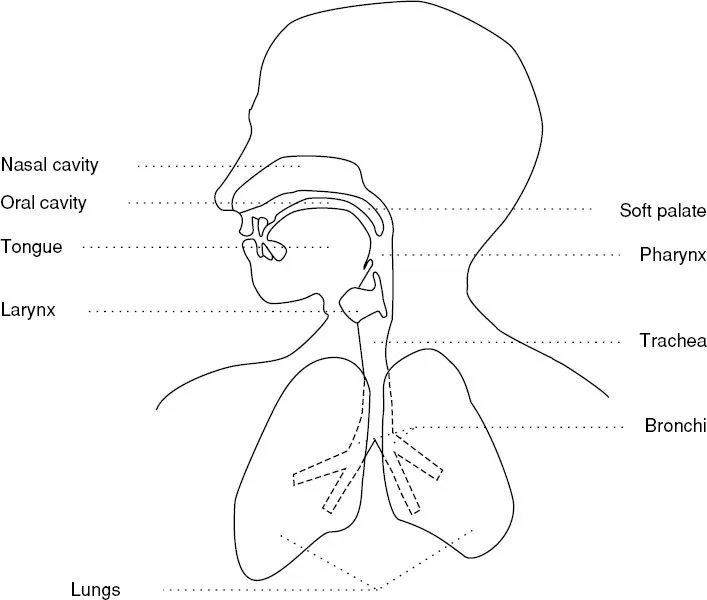![]()
Chapter 1
Introduction
Every day we hear many types of sounds: bells ringing, machinery clunking, dogs barking, leaves rustling, people talking. The science of acoustics studies sounds in general, and phonetics studies the sounds used in human language. Phonetics is part of the wider field of linguistics, which studies language as a whole.
Phonetics is concerned with the sounds we make in speech: how we produce them, how these sounds are transferred from the speaker to the hearer as sound waves, and how we hear and perceive them. Several thousand languages are spoken in the world; obviously we cannot look at the sounds of each one of them. We will examine English in detail first because it is the language that you are all familiar with; this will be followed by an introduction to acoustics. Finally we will survey the kinds of sounds found in languages all over the world.
In this chapter you will learn about:
• the basic fields of phonetics;
• the anatomy of the parts of the body used in making sounds;
• how to determine where in your mouth a sound is made.
At the end of each chapter you will find exercises which will enable you to practise producing sounds. The first portion of the exercises is basic and allows you to practise the sounds which have just been presented in that chapter. The advanced exercises include more difficult material, and they are cumulative, reviewing sounds already studied and incorporating the new material.
Phonetics involves a large number of technical terms. As new terms are discussed, they are shown in bold type. At the end of each chapter is a list of technical terms, and Appendix B presents a complete glossary of technical terms. These terms are essential to being able to talk about phonetics. Later work will go much more easily if you make a point of learning each term as it occurs.
The study of phonetics
Branches of phonetics
Articulatory phonetics
The branch of phonetics dealing with the production of sounds is called articulatory phonetics. In speech, air passes through a complex passageway consisting of the lungs, the windpipe, the vocal folds, the throat, the mouth, and the nose. In order to describe how sounds are made, we must become familiar with the various parts of our anatomy which are involved in speech production. We will also learn how we change the shape of the vocal organs to make different sounds.
Acoustic phonetics
From physics, we know that sound is transmitted by vibrations in the air. Acoustic phonetics studies the vibrations of speech sounds. With instruments in the laboratory, we can observe and measure various aspects of sound. In Chapters 7 and 8, we will learn how these measurements and observations can be used to widen our understanding of human speech.
Auditory phonetics
Auditory phonetics is the study of how sounds are heard and perceived. This area of phonetics generally falls outside the coverage of this book.
Articulatory phonetics
We begin our study of articulatory phonetics with an examination of the vocal organs, the parts of the body used in producing speech (Figure 1.1). The lungs start the process of speech production by pushing air upwards. The vocal folds, which are located in the larynx behind the adam’s apple, may vibrate, causing the air that flows between them to vibrate as well. The vibrating airstream is then modified according to the shape of the vocal tract – the throat, mouth, and nasal cavity. By moving our tongue and lips, we can produce a large number of modifications on the vibrating air stream, and thus, a wide variety of sounds.
A bicycle horn provides a simple model of how speech sounds are produced. In the bicycle horn, air is pushed out when the bulb is squeezed. The air then passes across the reed, located just past the bulb, which sets it in vibration. Finally, the air passes through the flared tube, the ‘horn’ proper, which gives a certain quality to the sound. In our body, the lungs are the bulb, pushing the air out. The vocal folds in the larynx are the reed, setting the air in vibration. The vocal tract is the ‘horn’ giving speech its particular quality. One important difference is that the bicycle horn can produce only one sound. The human vocal tract can be altered in many ways to produce a large variety of sounds.
Figure 1.1 The primary vocal organs
We will now look at the various parts of the vocal organs. In a number of cases, the Latin or Greek name is normally used in phonetics. These terms are given as they are needed. We need to become familiar with the anatomy and terminology of the vocal mechanism. This is basic information which will be used throughout the book.
Lungs
The lungs are cone-shaped structures in the chest composed of spongy, elastic material. The lungs consist of small air sacs, or alveoli, where oxygen from the fresh air is exchanged for carbon dioxide in the blood. When the lungs are expanded, air is drawn in; when they are compressed, air is expelled. We have a considerable amount of control over the rate of breathing. When speaking, we breathe in fairly quickly and then expel the air more slowly. In English, all speech is made as the air flows out of the body; that is, English speakers do not ordinarily talk while breathing in.
Trachea
The small tubes of the lungs merge with each other, repeatedly forming larger tubes, until they form two large tubes called bronchi, one bronchus coming from the left lung and one from the right lung. The two bronchi merge into a single vertical tube called the trachea or windpipe. The top of the trachea is just behind the notch at the top of the breastbone. In speech, the bronchi and trachea function simply as tubes to carry the air in and out of the lungs.
Larynx
The larynx is a structure made of several cartilages held together by ligaments and supporting several muscles; it is roughly cylindrical in shape and rests on top of the trachea. The front part of the larynx, known as the adam’s apple, sticks out in front. The vocal folds lie inside the larynx, just behind the point of the adam’s apple. They are two horizontal bands of ligament and muscle, lying across the air passage; they can open and close, acting as a valve for air coming from the lungs. ...

